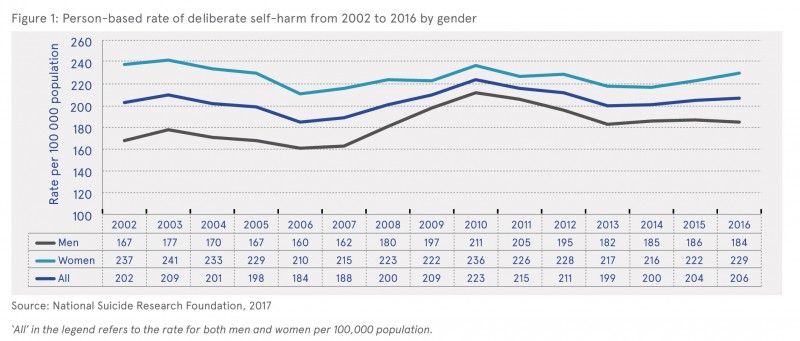Millar, Sean (2018) National Self-Harm Registry annual report, 2016. Drugnet Ireland, Issue 64, Winter 2018, p. 12.
| Preview | Title | Contact |
|---|---|---|
|
PDF (Issue 64, Winter 2018)
- Published Version
933kB |
The 15th annual report from National Self-Harm Registry Ireland was published in late 2017.1 The report contains information relating to every recorded presentation of deliberate self-harm to acute hospital emergency departments in Ireland in 2016 and complete national coverage of cases treated. All individuals who were alive on admission to hospital following deliberate self-harm were included, along with the methods of deliberate self-harm that were used. Accidental overdoses of medication, street drugs or alcohol were not included.
Rates of self-harm
There were 11,485 recorded presentations of deliberate self-harm in 2016, involving 8,909 individuals. Taking the population into account, the age standardised rate of individuals presenting to hospital in the Republic of Ireland following self-harm was 206 per 100,000 population. This is similar to the rate recorded in 2015 (204 per 100,000 population). In recent years, there have been successive decreases in the self-harm rate between 2011 and 2013. Nevertheless, the rate in 2016 was still 10% higher than in 2007, the year before the economic recession (Figure 1).
In 2016, the national male rate of self-harm was 184 per 100,000 population, 1% lower than in 2015. The female rate was 229 per 100,000 population, which was 3% higher than in 2015. Since 2007, the male and female rates of self-harm have increased by 14% and 7%, respectively. With regard to age, the peak rate for men was in the 20—24-age group at 516 per 100,000 population. The peak rate for women was among 15—19-year-olds at 763 per 100,000 population.
Self-harm and drug and alcohol use
Intentional drug overdose was the most common form of deliberate self-harm reported in 2016, occurring in 7,646 (67%) of episodes. As observed in 2015, overdose rates were higher among women (72%) than among men (59%). Minor tranquillisers and antidepressants/mood stabilisers were involved in 35% and 19% of drug overdose acts, respectively. In total, 32% of male and 47% of female overdose cases involved analgesic drugs, most commonly paracetamol, which was involved in 30% of all drug overdose acts. In 69% of cases, the total number of tablets taken was known, with an average of 29 tablets taken in episodes of self-harm that involved a drug overdose.
There was no increase in the number of presentations involving street drugs (cannabis, ecstasy and cocaine) compared to 2015 (n=547). Nevertheless, the 2015/16 levels are the highest recorded since 2008 and the second highest ever recorded by the registry. Alcohol was involved in 31% of all self-harm presentations, and was significantly more often involved in male episodes of self-harm than females (34% vs 29%, respectively). The authors reported that, as in previous years, alcohol continued to be one of the factors associated with the higher rate of self-harm presentations on Sundays, Mondays and public holidays, and in the hours around midnight.
The authors concluded that these findings underline the need for ongoing efforts:
- To reduce access to minor tranquillisers and other frequently used drugs, including paracetamol
- To intensify national strategies to increase awareness of mental health issues
- To intensify further strategies to reduce access to alcohol.

1 Griffin E, Arensman E, Corcoran P, Williamson E and Perry IJ (2017) National Self-Harm Registry Ireland annual report 2016. Cork: National Suicide Research Foundation. https://www.drugsandalcohol.ie/27916/
E Concepts in biomedical areas > Medical substance > Prescription drug (medicine / medication)
F Concepts in psychology > Behaviour > Self-destructive behaviour / self-harm > Suicidal behaviour / suicide
VA Geographic area > Europe > Ireland
Repository Staff Only: item control page